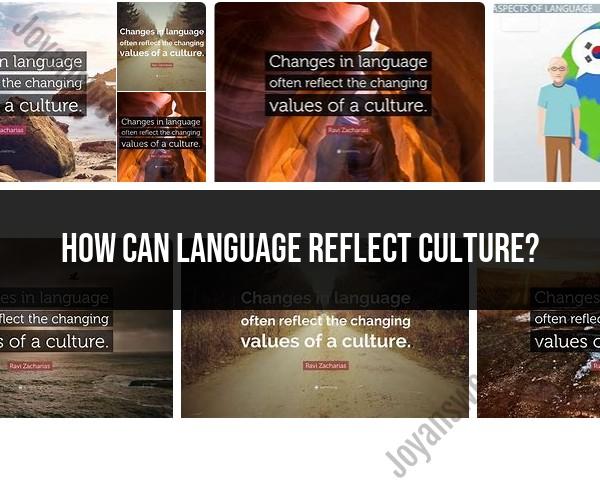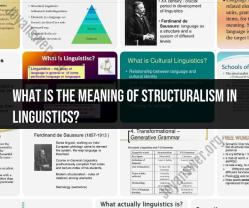How can language reflect culture?
Language and culture are deeply intertwined, and language often serves as a reflection of cultural norms, values, and identity. Here's how language can reflect culture:
Vocabulary and Terminology:
- Specific words and phrases in a language can reflect cultural concepts and values. For example, the presence of multiple words for snow in the Inuit languages reflects the importance of snow and ice in their culture.
Idioms and Expressions:
- Idioms, proverbs, and expressions often have cultural significance. Understanding these expressions can provide insight into the way people of a particular culture view the world. For instance, the English idiom "raining cats and dogs" is unique to English-speaking cultures.
Politeness and Etiquette:
- The way people express politeness and etiquette can vary greatly between cultures. Language reflects these differences through formal and informal language forms, honorifics, and polite phrases used in interactions.
Social Hierarchy and Status:
- Many languages have different forms of address and verb conjugations based on the social status and relationships between individuals. This reflects the importance of hierarchy in certain cultures.
Narrative Styles:
- The way stories are told, the use of symbolism, and narrative techniques can vary between cultures. For example, some cultures place a strong emphasis on oral storytelling traditions.
Cultural References and Symbols:
- Language often includes references to cultural symbols, myths, and historical events that hold significance within a specific culture.
Gender Roles and Gendered Language:
- Some languages use gendered language to reflect societal roles and expectations related to gender. For instance, Spanish uses gendered nouns and adjectives.
Taboos and Taboo Language:
- Taboo language and words considered offensive vary from culture to culture, reflecting what is considered inappropriate or disrespectful in a given society.
Naming Conventions:
- The way people are named, including the structure of names and the use of titles, can vary widely based on cultural norms and customs.
Dialects and Regional Variations:
- Language often varies by region, reflecting regional cultural differences in pronunciation, vocabulary, and grammar.
Cultural Borrowing and Language Change:
- As cultures interact and exchange ideas, languages may borrow words, phrases, and concepts from one another, reflecting cultural exchange and globalization.
Humor and Wit:
- Jokes and humor are often deeply rooted in cultural context and language. What is funny in one culture may not translate well in another.
Emotions and Expressiveness:
- The way emotions are expressed and discussed can vary between cultures, with some languages having more words for specific emotions or concepts.
Understanding the connection between language and culture is essential for effective communication, cross-cultural interactions, and appreciating the rich diversity of human societies. It also highlights the importance of cultural sensitivity and awareness in language use and translation.
How does language reflect the culture of a society?
Language reflects the culture of a society in a number of ways. For example:
- Vocabulary: The words that a language has reflect the things that are important to that culture. For example, the Inuit language has many words for different types of snow and ice, reflecting the importance of these elements in their culture.
- Grammar: The grammar of a language can reflect the cultural values of a society. For example, some languages have a complex system of honorifics, which is used to show respect to people of higher social status. This reflects the importance of hierarchy in those cultures.
- Usage: The way that people use language can also reflect cultural values. For example, in some cultures, it is considered rude to interrupt someone when they are speaking. This reflects the cultural value of respect.
What are some examples of how language and culture are interconnected?
Here are some examples of how language and culture are interconnected:
- Proverbs and idioms: Proverbs and idioms are often rooted in cultural values and beliefs. For example, the English proverb "A bird in the hand is worth two in the bush" reflects the cultural value of caution.
- Slang: Slang terms are often used to reflect cultural trends and experiences. For example, the English slang term "selfie" was coined in the early 21st century to reflect the growing trend of people taking self-portraits with their smartphones.
- Place names: The place names in a region can often tell us about the history and culture of that region. For example, the many places in the United States with Native American names reflect the fact that Native Americans were the original inhabitants of the land.
How can changes in language reflect societal and cultural shifts?
Changes in language can reflect societal and cultural shifts in a number of ways. For example:
- New words: New words are often introduced into a language to reflect new technologies, ideas, and social trends. For example, the English word "internet" was coined in the late 1960s to reflect the development of the internet.
- Changes in meaning: The meaning of words can also change over time to reflect societal and cultural shifts. For example, the English word "gay" used to mean "happy," but it now has the primary meaning of "homosexual." This change in meaning reflects the growing acceptance of homosexuality in society.
- Language shift: Sometimes, entire languages can disappear or be replaced by other languages. This can happen due to globalization, colonialism, or other social changes. For example, many Native American languages are disappearing due to the influence of English.
What is the role of language preservation in maintaining cultural heritage?
Language preservation is important for maintaining cultural heritage because language is a key part of culture. It is through language that we transmit our cultural values, beliefs, and knowledge to future generations. When a language disappears, it takes with it a part of that culture.
There are a number of things that can be done to preserve languages, such as:
- Teaching languages in schools: This is one of the most important things that can be done to preserve languages. When children learn a language in school, they are more likely to continue using it as adults.
- Encouraging the use of languages in the media: This helps to make languages more visible and accessible to people. For example, some television channels and radio stations broadcast programs in multiple languages.
- Supporting language communities: This can be done by providing funding for language programs and organizations, and by promoting the use of languages in public spaces.
Can you explain the concept of linguistic relativity and its impact on culture?
Linguistic relativity is the hypothesis that the language we speak influences our perception of the world. It is also known as the Sapir-Whorf hypothesis, after the two linguists who developed it.
There is some evidence to support the hypothesis of linguistic relativity. For example, studies have shown that people who speak different languages have different ways of thinking about time and space. However, more research is needed to fully understand the relationship between language and thought.
If linguistic relativity is true, it suggests that language plays an important role in shaping culture. The language we speak influences the way we see the world, and the way we see the world influences our culture.
For example, the Yupik people of the Arctic have many words for different types of snow and ice. This reflects the importance of these elements in their culture. The Yupik people also have a different way of thinking about time than people who speak English. They view time as cyclical, rather than linear. This different way of thinking about time may be influenced by their language.
The concept of linguistic relativity is important because it suggests that language is not just a tool for communication. It also plays a role in shaping our thoughts and perceptions









